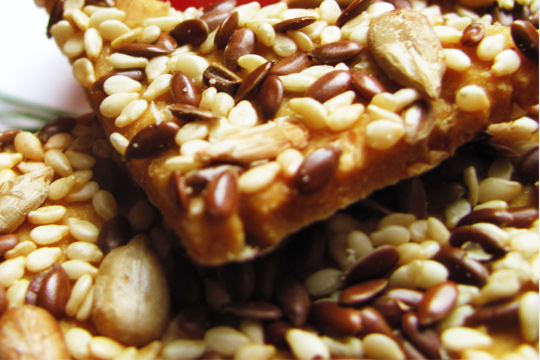
Reducing Food Waste in Foodservice
October 16, 2018 by Doreen Garelick, Dietetic Intern
Our intern Doreen attended a food waste summit for restaurants and compiled these tips to help food service operators redirect…
Nutrition 101
August 16, 2012

Culinary Nutritionist Natalia Hancock explains the benefits of fiber and why it's a crucial part of the human diet, before discussing the differences between soluble and insoluble fibers.
Dietary fibers are the indigestible part of plants that humans do not absorb, but as they pass through the body they provide various health benefits. The USDA recommends 25-35 grams of fiber per day, however some statistics show that many Americans are only ingesting around 15g a day.
There are two types of dietary fiber: soluble and insoluble. A diet high in both types of fiber is important for health, digestion and disease prevention for conditions such as obesity, heart disease, diabetes, diverticulitis, and constipation. So what are the differences between soluble and insoluble fiber?
Soluble fiber dissolves in water and turns into a gel, which helps slow down digestion. Having foods containing soluble fiber during meals and snacks will help us feel full for an extended period of time. A diet high in soluble fiber can also help lower cholesterol and prevent heart disease. To help feel fuller for longer, it's important to eat foods that contain soluble fiber, such as oat bran, barley, nuts, seeds, beans, lentils and peas as well as other fruits and vegetables.
Insoluble fiber does not dissolve in water but remains intact. This is good for our digestive tracts because it increases motility with the added bulk. Eating foods high in insoluble fiber throughout the day can help to prevent constipation. Foods that contain insoluble fiber include whole grains, nuts, seeds, legumes, leafy greens, fruit and root vegetable skins.
A healthy diet including fruits, vegetables, whole grains, legumes, nuts and seeds will provide enough of both soluble and insoluble fiber and you will reap all the health benefits associated, so if you're already eating these foods you don’t need to worry about getting enough of each type of fiber. If you are setting out to increase the fiber in your diet, you might find some stomach discomfort when having cereals or bars marketed for high fiber. Don’t get discouraged - it is best to gradually increase the amount of fiber in your diet. And don't forget to drink plenty of water!

October 16, 2018 by Doreen Garelick, Dietetic Intern
Our intern Doreen attended a food waste summit for restaurants and compiled these tips to help food service operators redirect food waste from landfills.
Nutrition 101

Nutrition 101
September 26, 2018 by Doreen Garelick, Dietetic Intern
Ever notice headlines about rapid weightloss? Dietetic Intern Doreen Garelick looks deeper into a recent eye-catching headline to see if there's any truth behind it.
Connect
 Follow us on Twitter
Follow us on Twitter Friend us on Facebook
Friend us on Facebook Follow us on Pinterest
Follow us on Pinterest Follow us on Instagram
Follow us on Instagram Read our Blog
Read our Blog Watch videos on YouTube
Watch videos on YouTube Watch videos on Vimeo
Watch videos on Vimeo Connect with us on Linkedin
Connect with us on Linkedin Find us on Foursquare
Find us on Foursquare
Tweets by @SPEcertifiedBlog Search
Categories
SPE Certified Newsletter
Sign up for news on the latest SPE-certified venues, events and SPE updates.
We will never share your personal information with a third party.